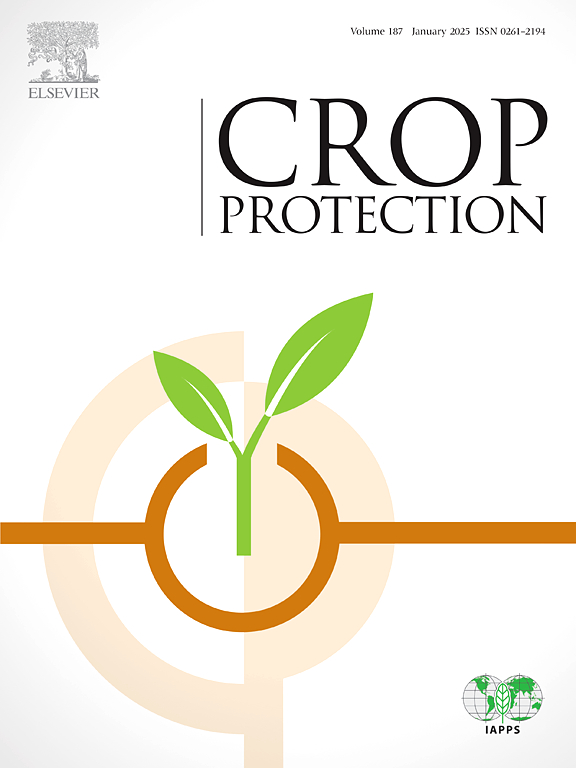Rapid and simple detection of alfalfa mosaic virus using RT-RPA-CRISPR-Cas12a based lateral flow assay in alfalfa crops in China
IF 2.5
2区 农林科学
Q1 AGRONOMY
引用次数: 0
Abstract
Alfalfa mosaic virus (AMV) has been reported as one of the most common and serious alfalfa-infecting viruses, significantly impacting alfalfa production worldwide. To establish a rapid and simple method for AMV detection in alfalfa crops in China, three novel methods were developed, including real-time fluorescent reverse-transcription recombinase polymerase amplification (RT-RPA), a one-tube one-step RT-RPA-CRISPR-Cas12a-based fluorescent assay, and a one-tube one-step RT-RPA-CRISPR-Cas12a-based lateral flow assay. RT-RPA-CRISPR-Cas12a-based detection methods combine one-step RT-RPA with CRISPR-Cas12a-based fluorescent or lateral flow detection in a single tube. Considering sensitivity, reaction time, ease of operation, and portability of instruments and reagents, the one-tube one-step RT-RPA-CRISPR-Cas12-based lateral flow assay was identified as the most suitable method for rapid field detection of AMV. This assay utilizes a pair of specific RT-RPA primers and a specific crRNA designed based on the conserved multifunctional coat protein gene sequences from 26 AMV isolates. The assay could be completed in approximately 1 h under isothermal conditions at 42 °C and 37 °C using a portable metal incubator. Sensitivity tests demonstrated that the assay could detect as low as 9.0 pg of total RNA extracted from AMV-infected alfalfa plants collected from Inner Mongolia, Hebei, Beijing, and Shanxi provinces in China, with no cross-reactivity with other alfalfa-infecting viral pathogens. Furthermore, its feasibility was validated by testing field-collected alfalfa samples. In conclusion, the developed one-tube one-step RT-RPA-CRISPR-Cas12a-based lateral flow assay offers a simple, sensitive, and efficient method for rapid AMV detection in the field, showing significant potential for practical applications.

RT-RPA-CRISPR-Cas12a横向流动法快速简便检测中国苜蓿花叶病毒
据报道,苜蓿花叶病毒(Alfalfa mosaic virus, AMV)是最常见和最严重的苜蓿侵染病毒之一,严重影响了全世界的苜蓿生产。为了建立一种快速简便的检测中国苜蓿作物AMV的方法,本研究建立了实时荧光反转录重组酶聚合酶扩增(RT-RPA)、基于RT-RPA- crispr - cas12的一管一步荧光法和基于RT-RPA- crispr - cas12的一管一步横向流动法3种新方法。基于RT-RPA- crispr - cas12的检测方法将一步RT-RPA与基于crispr - cas12的荧光或侧流检测在单管中结合起来。考虑到灵敏度、反应时间、操作简便以及仪器和试剂的便携性,基于rt - rpa - crispr - cas12的单管一步侧流法被认为是最适合AMV现场快速检测的方法。该实验利用了一对特异性RT-RPA引物和基于26株AMV分离株的保守多功能外壳蛋白基因序列设计的特异性crRNA。在42°C和37°C的等温条件下,使用便携式金属培养箱,大约1小时即可完成检测。灵敏度试验表明,从内蒙古、河北、北京和山西等地采集的感染amv的苜蓿植株中提取的总RNA可低至9.0 pg,与其他感染苜蓿的病毒病原体无交叉反应。并通过田间采集的苜蓿样品验证了该方法的可行性。综上所述,基于rt - rpa - crispr - cas12的单管一步侧流检测方法为现场快速检测AMV提供了一种简单、灵敏、高效的方法,具有重要的实际应用潜力。
本文章由计算机程序翻译,如有差异,请以英文原文为准。
求助全文
约1分钟内获得全文
求助全文
来源期刊

Crop Protection
农林科学-农艺学
CiteScore
6.10
自引率
3.60%
发文量
200
审稿时长
29 days
期刊介绍:
The Editors of Crop Protection especially welcome papers describing an interdisciplinary approach showing how different control strategies can be integrated into practical pest management programs, covering high and low input agricultural systems worldwide. Crop Protection particularly emphasizes the practical aspects of control in the field and for protected crops, and includes work which may lead in the near future to more effective control. The journal does not duplicate the many existing excellent biological science journals, which deal mainly with the more fundamental aspects of plant pathology, applied zoology and weed science. Crop Protection covers all practical aspects of pest, disease and weed control, including the following topics:
-Abiotic damage-
Agronomic control methods-
Assessment of pest and disease damage-
Molecular methods for the detection and assessment of pests and diseases-
Biological control-
Biorational pesticides-
Control of animal pests of world crops-
Control of diseases of crop plants caused by microorganisms-
Control of weeds and integrated management-
Economic considerations-
Effects of plant growth regulators-
Environmental benefits of reduced pesticide use-
Environmental effects of pesticides-
Epidemiology of pests and diseases in relation to control-
GM Crops, and genetic engineering applications-
Importance and control of postharvest crop losses-
Integrated control-
Interrelationships and compatibility among different control strategies-
Invasive species as they relate to implications for crop protection-
Pesticide application methods-
Pest management-
Phytobiomes for pest and disease control-
Resistance management-
Sampling and monitoring schemes for diseases, nematodes, pests and weeds.
 求助内容:
求助内容: 应助结果提醒方式:
应助结果提醒方式:


